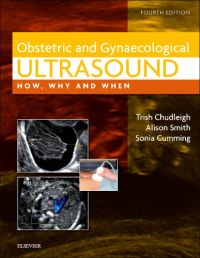This established text covers the full range of obstetric ultrasound examinations that a sonographer would be expected to perform in a general hospital or secondary referral setting, and is the only text that combines the practicalities of learning how to perform these examinations with the information needed to carry them out in a clinical setting. It encourages students to think about their practice and provides the sonographer with the necessary tools to provide a 'gold standard' service.
New to this edition
- Scope fully expanded to cover gynaecological ultrasound imaging including:
- the physiological changes taking place during the menstrual cycle
- the effects of exogenous hormones on the various ultrasound appearances during the menstrual cycle
- the ultrasound appearances of common abnormalities of the uterus, ovaries and adnexae
- the ultrasound assessment of an adnexal mass using a standardized approach
- New images to reflect the improvements in imaging technology
- New chapter on screening for Down’s syndrome and Edwards’ and Patau’s syndromes in accordance with current national screening recommendations
- New chapter on the medico-legal issues relevant to performing and reporting ultrasound examinations
Key Features
- Explains the principles of grey scale ultrasound, Doppler ultrasound and instrumentation
- Addresses problems from both practical and clinical viewpoints
- Provides comparative images showing results of good and bad scanning techniques
- Advises on how to communicate findings to a pregnant woman or gynaecological patient
- Discusses both the normal and abnormal ultrasound appearances for each of the relevant anatomical areas together
Author Information
Edited by Trish Chudleigh, PhD, DMU, Specialist Sonographer for Education & Training, The Rosie Hospital, Cambridge University Hospitals NHS Foundation Trust, Cambridge, UK; Alison Smith, MSc, DMU, Tutor Sonographer, Women's Health & Fetal Medicine, Guy's & St Thomas' NHS Foundation Trust, London, UK and Sonia Cumming, RGN, RM, PGCert, Midwife Sonographer, The Rosie Hospital, Cambridge University Hospitals NHS Foundation Trust, Cambridge, UK
Contributor
Foreword
Preface
Acknowledgements
1 The principles of ultrasound, Doppler ultrasound and instrumentation
2 Preparing to scan
3 Starting to scan using the transabdominal route
4 Starting to scan using the transvaginal route
5 Assessing the early intrauterine pregnancy
6 Problems of early pregnancy
7 Dating and screening the pregnancy between 10 and 14 weeks
8 First steps in examining the second trimester pregnancy
9 Assessing the fetal head, brain, neck and face
10 Assessing the chest and heart
11 Assessing the abdomen
12 Ultrasound assessment of the spine and limbs
13 Assessing fetal growth, amniotic fluid, fetal and uterine artery
Dopplers
14 Placental and cervical imaging
15 Multiple pregnancy
16 Scanning the non pregnant pelvis
17 The menstrual cycle, the menopause and the effects of exogenous
hormones
18 Uterine and ovarian anomalies
19 Characterization of adnexal cysts, differential diagnoses of the pelvis
and report writing
20 Professional issues
Appendix 1 Orientation and fetal lie
Appendix 2 Equation and look-up table for estimating gestational age
(GA) from the crown rump length (CRL) as recommended
by current national guidelines
Appendix 3 Head circumference (HC) dating table and equation
Appendix 4 Biparietal diameter (BPD) dating table (‘outer to inner’)
Appendix 5 The 11 conditions screened for, together with their current
expected detection rates, within the national screening
programme
Appendix 6 Equation, head circumference (HC) size chart and HC size table
Appendix 7 Biparietal diameter (BPD) size chart (‘outer to inner’)
Appendix 8 Equation, abdominal circumference (AC) size chart and AC
size table
Appendix 9 Equation and dating table for estimating gestational age (GA)
from the femur length (FL)
Appendix 10 Equation, femur length (FL) size chart and FL size table
Appendix 11 Markers of chromosomal abnormality 475
Index




